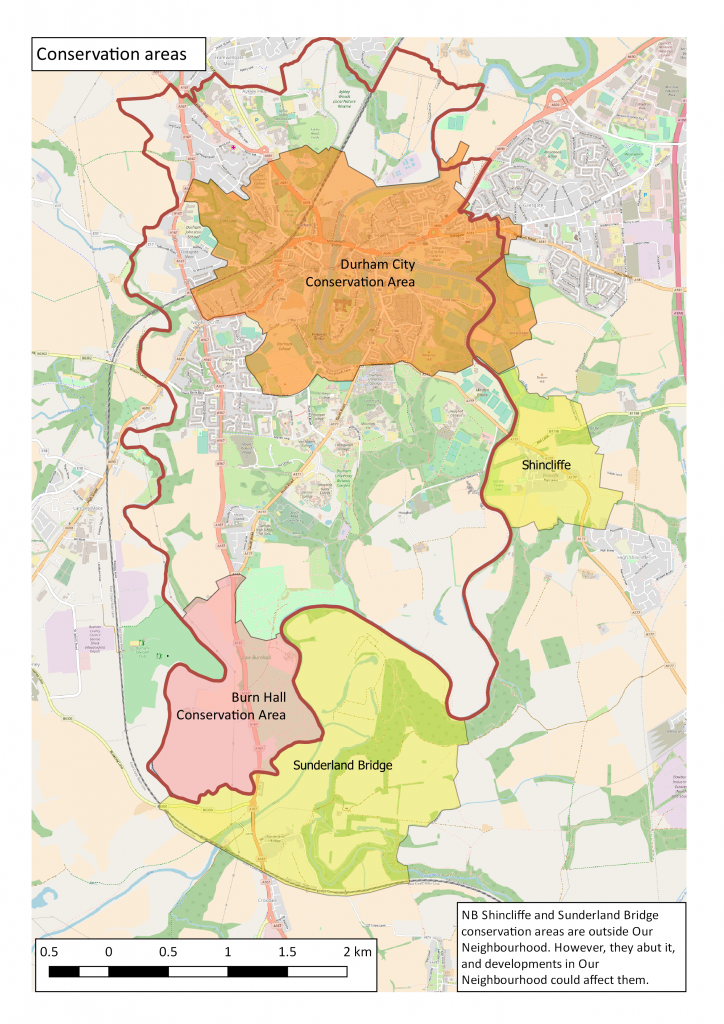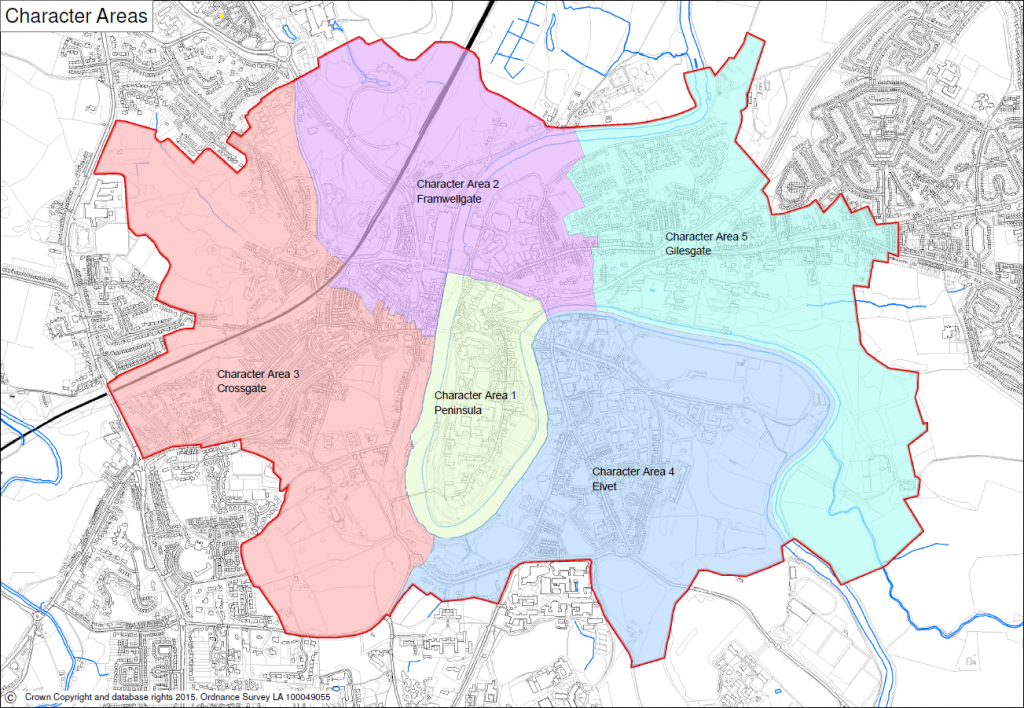Policy H2: The Conservation Areas
H2.1: The Durham City Conservation Area will be protected and enhanced by supporting Durham County Council’s Management Plan for this area.
H2.2: Development proposals within and affecting the Durham City Conservation Area and Burn Hall Conservation Area will only be permitted if they fulfil the following requirements:
- retain, or enhance, the continuous frontages respecting the historic and architectural qualities of the buildings unless it can be demonstrated that the substantial harm to or loss of such frontages are necessary to achieve substantial public benefits that outweigh that harm or loss; and
- have sensitive scale, density, massing, height, landscape, layout, detailing and materials to reflect the intrinsic local character; and
- avoid demolition of buildings of historic and/or architectural interest which contribute to the character and appearance of the locality, unless it can be demonstrated that the loss is necessary to achieve substantial public benefits that outweigh the loss; and
- avoid loss of an element of a building which makes a positive contribution to its individual significance and that of the immediate area unless it can be demonstrated that the substantial harm or loss of the element is necessary to achieve substantial public benefits that outweigh that harm or loss; and
- use traditional and non-traditional design sympathetic to the traditional character of the area; and
- have high design quality with regard not just to the context of the immediate area and its local distinctiveness, but also to the landscape and the setting of the Durham World Heritage Site. Applicants need to convincingly demonstrate their understanding of the site’s context and how it has influenced their design; and
- maintain the historic streetscape with regard to the medieval street patterns of tightly packed buildings, covering both the back and front of plots; and
- ensure a presumption in favour of retaining historic burgage plot boundaries; and
- provide or improve pedestrian access and connectivity of the development to the rest of the city; and
- avoid the cumulative impact of development schemes dominating either by their size, massing or uniform use.
Map 4: Map of the Conservation Areas
 Here is a zoomable map of the conservation areas.
Here is a zoomable map of the conservation areas.
Map 5: Map of Durham City Conservation Area with Character Areas Shown
Here is a zoomable map of the character areas.
4.46 Durham City Conservation Area (Boundary Map 4; and Map 5 of Character areas) includes the Peninsula with the Cathedral and Castle as its centrepiece, the Market Place and medieval streets leading from Silver Street to the west, Claypath to the north-east, Elvet to the east and the slightly more distant medieval suburb of Gilesgate. The natural ‘bowl’ in which the City is located, topography, the importance of green wedges of countryside and other significant green areas contribute significantly to, and enhance, the setting of the historic townscape of the City as a whole. The conservation area is widely recognised as being of outstanding importance. Specific districts within the Conservation Area have been identified, each with a distinctive character. The Character Areas in the Durham City Conservation Area which fall in Our Neighbourhood are: Peninsula Area, Framwellgate Area, Crossgate Area, Elvet Area and Gilesgate Area. Policy H2 applies to all the character areas. Aspects specific to individual character areas are covered in policy H3.
4.47 The Burn Hall Conservation Area (Boundary Map 4) includes the country estate of Burn Hall (listed grade II*) with a complex of late eighteenth and early nineteenth century buildings, which stand in a site of 72 hectares. The estate is situated three miles south of Durham City in a rural area, adjacent to the west side of the A167 road, and is enclosed to the north, west and south by the River Browney. The Hall faces south with land falling away and offering views of the river. The principal building is a two storey sandstone Hall designed by Ignatius Bonomi (with an impressive porte-cochere entrance). In the grounds are a nineteenth century wooden conservatory (listed grade II) and a stone ice house (listed grade II). In the park the Home Farm complex includes a stone Cow House and brick Bull House (late eighteenth century listed grade II*). Nearer the Hall, the walled kitchen garden and estate cottages, now converted into offices, date from the late eighteenth century (listed grade II). The grounds are a Grade II registered park and garden.
Justification
4.48 Conservation Areas are places where buildings and spaces around them interact to form distinctive visible areas of quality and interest. Designation means that close consideration is given to proposals for change so that the special qualities of an area are preserved or enhanced. (PPG, para. 003 ID: 18a-003-20140306).
4.49 The City of Durham is one of the most important historic cities in Britain. The quality and architectural coherence of the buildings, combining medieval elements with Georgian and Victorian later interventions, contributes to the historic environment. A medieval network of streets and alleyways (vennels), centred on the Peninsula and radiating outwards, with dramatic topography and extensive green spaces make the Durham City Conservation Area exceptional. The City’s unique townscape forms the immediate setting of the World Heritage Site, its streets and domestic scale emphasising the World Heritage Site’s dominance.
4.50 Durham City was designated as a conservation area in August 1968 focusing on the peninsula, and the area covered was significantly enlarged in 1980 to incorporate a much larger section of the city centre. The Durham City Conservation Area was reviewed in 2015, with some boundary changes, and a character appraisal document produced and formally approved on 29th July 2016. A management proposals section is included in the individual Character Area documents (Durham County Council, 2016e) and development must be in compliance with these. However, the management plan for the Durham City Conservation Area has not yet been published.
4.51 The significance of Durham’s historic environment is recognised and cherished by experts and local people, who responded to the Durham City Conservation Area appraisal consultation and appreciate that national heritage is a significant economic and social resource. These responses are summarised in the individual Character Area appraisal documents (Durham County Council, 2016e). The intense public interest in sustaining and enhancing the distinctive character of the individual areas within the Durham City Conservation Area indicates the need to ensure that the area’s heritage significance and sense of place are given appropriate weight in planning decisions. Proposals for change should be considered in the context of the impact on the heritage significance of the assets affected and their setting. The importance of participation and enjoyment of the historic environment for present and future generations must be supported by development that is of high quality in both design and execution and has a durable quality: aspiration for imaginative and well-designed buildings is strongly recommended by Historic England (2008, para.138).
Next section: Policy H3: The Character Areas



3 Responses to Policy H2 2017